anchor
final review

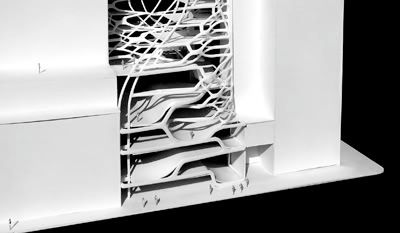
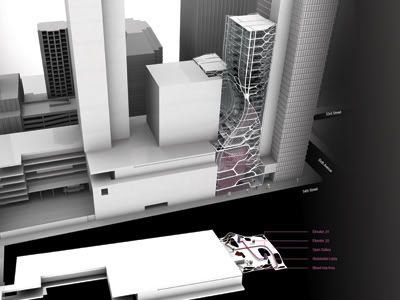
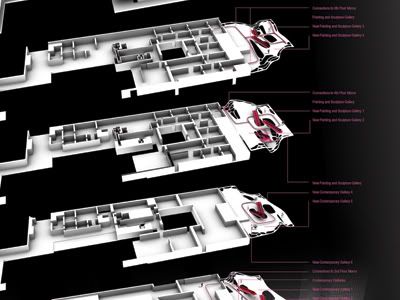
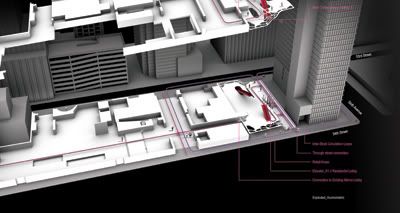
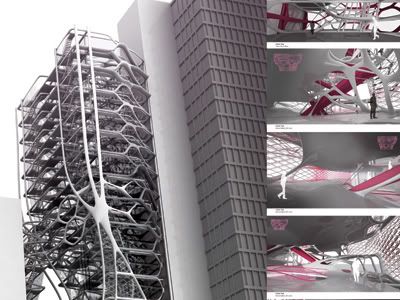
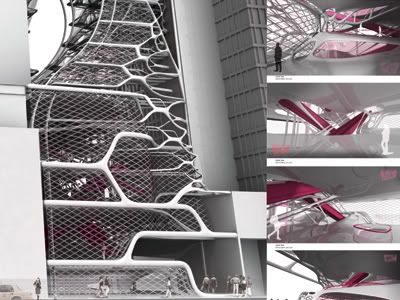
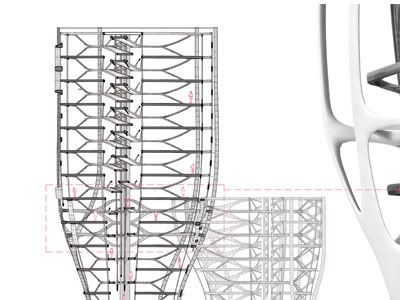
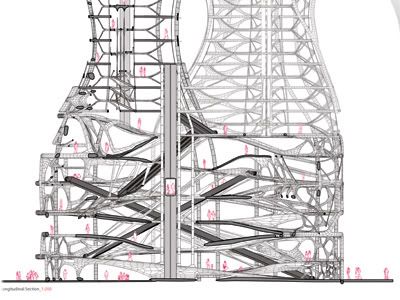



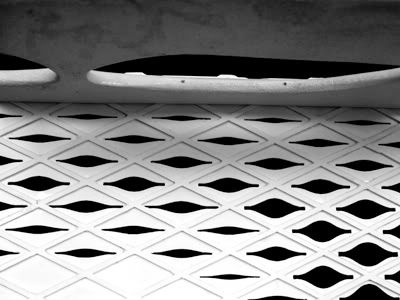
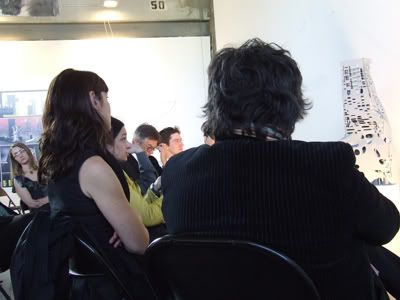

as sad as it may sound, i'm going through a bit of studio withdraw right now as i upload these images from our final review. the delerium has come to a sudden halt, and i am left to wonder what to do with all this free time...
the presentations went well for us. there was high praise for our level of production which i believe is the result of working hard and working well as a group even though at times we would have our differences. i have to thank my partners for really kicking ass and always providing some late night laughter.
the jurors for us included: hernan diaz-alanso, neil denari, georgina huljich, sulan kolatan, jonas runberger, stephen philips, matt melnyk, and jawn lim
for the most part, the feedback was very positive and the major topics of critique were issues of optimization (denari), skin (kolatan), interlaced with a few philosophical gems from stephen philips...hernan provided some good comic relief as usual.
p.s. don't forget the end of the year exhibit this saturday! 5-7



















23 Comments
honestly no stereotyping in that last picture - i'm sitting here wearing all black looking at a bunch of architects wearing all black. We are a pathetic race...sigh
Anyhow I really like the work, it reminds me of those parasite projects of the early 00s but has an aesthetic of ONL meets Hadid post-Pritzer
you should be VERY proud, particularly that despite its obvious contemporary aesthetic it how it could be constructed comes across in the renders and presentation
thanks archphilia, i knew the all black comment was coming...it wasn't planned, i swear.
p.s. there is no question that our group has an affinity for a contemporary aesthetic (esp within the MArch II progrom), but unlike last semester, there was a good emphasis on physical model making which i appreciated, and really tried to embrace this semester.
i was going to comment similarly to architechno. i have been looking at the aa website and all of the projects seem to run together. your project is very similar to that same vocabulary, but it seems much more sophisticated. archi put it right when he said that he could understand how it could be constructed. that is very exciting!
its just so sexy.
i wonder about the skin though. i wish it were rendered on the overall building perspectives and not just the detail.
I was wondering what software you used to model this is it maya? polygons/subdivisions because I think it is really controlled and well articulated compared to a lot of projects with that same vocabulary.
I like it!
what are the construction materials and what are the real advantages of building with this structural system?
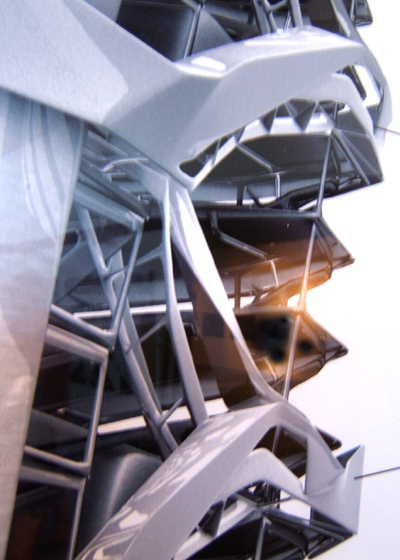
what building codes would be challenged with this building and what would be a reasonable argument to win those challenges?
and lastly,
what makes this project any different than the similar ones i saw there last year, under the same instructors?
i agree with Orhan. let me add this; while it is interesting and sexy it is also quite safe. i mean i've seen numerous similar projects. let me ask this; if in doing this have you ever considered having your scheme "attacking" or "infecting" the other buildings around it? why not? why can't we see something that undermines, infects, destabilizes, acts like a cancer/growth?? when i see the background i wonder, what's next, what could be...?
Come on Orhan,
Sometimes we need to leave the question of code violation, temporarily to the side inorder to let the mind create something in the first place.
No one is going to build this as is, and I'm sure when it comes to that, design development will include issues of public safety.
Tim: Great job.
I think that a lot of the questions raised here are very stereotypical when work like this is produced. Viewers have seen these a million times before but in reality work like this ( and many others) is what in the end big offices end up copying and applying in much safer approaches than Tim's group here.
Congratulations on finishing your graduate education. I can only wish you good luck and take your time finding the right office / environment to work because if you head straight into a big office all your curiosities and energy can be flattened out in less than a second.
Word of advice: Take your time and find the right place, if not you'll end up like a lot of other students who loose their passion and energy and end up complaining about the profession.
BTW: That is the biggest ZCorp model I have ever seen!!!
you guys didn't get what i asked. i am not against any of this as you are super defensive of few things that i am not even questioning. on the contorary i am all for it and i am raising these questions that the designers of these projects will be asked over and over and better get use to answering them in a sensible fashion.
yes the building codes are very important issue that must be slowly incorporated to this technology based designs.
cost is another one and i will add buildibility to that for bonus question;).
please don't get too far and start to act like minor geniuses before anything becomes even semi considirable level.
there are are safety, fire and other issues must be resolved before anything else anyway. is it too much to ask. or should i just stand back and say wow this is great..
well i have done that about 15 years ago.
c'mon. MOVE.
If I'm in this building and it's burning down, I'm not sure I want to have to navigate that alien stairway to get out...
does that facade operate? That would be cool... like Institut du monde arabe. Why did you choose to render the building without the skin, time constraints?
final images were presented with no process or other documentation, what are we supposed to react too? do we just say great images and move on?
i thnk what happens is that our "stereotypical" remarks are met with a "stereotypical" response. it's defensive posturing; i am not critiquing your ability to think or create wonderful things, i am critiquing what i see or don't see.
this image looks like 24 frames-per-second of a laughing mouth
good work - yeah it's been done before but i think all students need to work through projects like this in order to move on ..
thanks for the comments everyone, i'm always up for initiating a good debate!

i'll try to address everyone's comments in between laundry loads, naps, and coffee runs, so forgive me if my responses are a bit scattered.
first bucku, we actually addressed the skin as a parametric problem as part of our CATIA elective, so there are actually about 20 iterations of our skin system on the building. i think we just had a tough time deciding on one. the project brief called for the building to be adaptable, so although the panels are not mechanical like the arab institute, they are interchangable depending on program changes and lighting reuirements. there was a 30 pg dossier on the parametric skin alone that we included in the presentation, but just didn't end up on the final boards.
orhan, i think you raise some excellent questions, and i will try to explain how we addressed them, but please bare in mind that i am limited to sharing the entire project (process) with just a webpage format. if you can make it to the exhibit opening, i'd be glad to have a discussion with you. i'm the guy smiling in the picture.
our overall objective was to challenge the convention of a centralized core, and stacking plates, and try to offer alternative solutions to high-rise mixed-use construction. the building form and morphology are derived from our analysis of circulation; at the urban scale and local interfaces with the existing MoMA. vertical egress is overlayed onto this system (all within code) which we used as driving splines for the residential tower. the egress splits and converges, but is all relatively straight forward if you follow the plan.
eliminating a centralized structural core created a challenge for us. our solution was distibute loads to the exoskeleton of the building, which is very articulated, but we tried to make it light and elegant.
stourley, same issue with webpage limitations, your critique is good and was also raised by a friend of mine. he said our building was very obedient to the zoning requirements and could see more interuption into the adjacent buildings to provide 'sky garden' type spaces. i tended to agree with that, but it became a matter of negotiating amongst the team and timing...maybe something i will develop in my portfolio.
francisco, just to clarify, i have not graduated. i just completed the first year of the two year program, so i still have a ways to go...and for the model, we actually built that thing within a budget ($800 total) and it stands 12.5" tall at 1:300scale. only the structural facades are 3dprinted. the folding plates were created from milling a foam mold and vacuum forming polystrene. there is at least a good 3 days of x-acto time in that model. the biggest 3d print model i have seen was actually done by our instructor, peter testa, who created two 3dprints standing over 4' tall at the cost of $100,000 each!
overall, in terms of a shared vocabulary, i think it's true. denari stated as a general comment after our review that innovation was too big a task for one person, and the day of the genius architect is over. that is why SCI-Arc embraces collaborative efforts not just within SCI-Arc, but a network of schools: Columbia, AA, Vienna that choose to take this type of work on. i am fully aware that this project exist within this school of ideas, shared ideas...cause that's what school is about right? innovation occurs as result of reiteration, and hopefully you see that we worked really hard to take these tools and ideas to make something that is our own. maybe not new, but our own.
thanks dot. next time i am in sci arc i'll look up for you and maybe we can go over some questions i've had and have coffee.
congratulations to you and the team by the way.
Hmmm- coreless mixed use towers are quite a challenge, and it looks like you may have succeeded within the realm of a (first year!) studio project. so how many folks were on the team?
What material were you dreaming off? cnc concrete printing? how do you place the rebar?
next I'm curious about the urban implications, since you stayed comfortably within the site boundaries and don't challenge the adjacent projects. So how does this 'urban object' create a vibrant street life- the base seems like a typical high rise ostentatious lobby that really doesn't engage the street/sidewalks, or create a strong transitions between inside and out, you just slide in.
the relationship between the structure and the cladding is ambiguous in the images- what is inside and what is outside? (watch out for those pigeons!)
can your structural/circulation strategy be applied to a landscraper, single family houses, or the typical suburban strip mall?
With all the attention placed on optimizing the structure/circulation (and getting distracted by the fetish for winking eyes in the skin), how is temporality addressed? your structure seems to not allow for much change in program/use or future growth. if you chopped off the top ten floors, how would the building stand?
Finally, the floor plates seem rather deep for good daylighting, residential use, or anything else then big box retail and office cubicle hell- were your instructed to make a 20 story 300,000 square foot building and your grade would be reduced if you missed either the height restriction or the FAR?
tim, it's a strong project- my questions are just to get you to think about the next step and not rest on your laurels...
congrats on all the hard work resulting in a provocative project. now i got some questions.
1. I may have missed it but what is the program exactly? its a high rise with a lower flat building, but what is it? (okay i can read some of the plan mixed use residential/gallery etc)
2. why is the tall portion so ektoskeletally expressive while the low part appears to be just some rat maze boxy room layout?
3. what happens in the narrow part of your taller hourglass form. looks too narrow to be anything at all.
4. why all the curving and fluidity just to cut the towers off in a flat roof fashion and why do they end where they end? why not taller?
5. the tower seems to be vinelike and seems as though it would want to move into/onto the surrounding building.
6. most highrise residential have private elevators. most art museum galleries in the sky have freight elevators.
7. ibc allows for a monumental stair but if im reading the plan right the eggress stairs have some issues
8. architects. do not be afraid of color. it's spring!
9. great job!
ah treekiller, you are my favorite cynic...really, and you do raise some legitimate concerns if i were to take this project further into DD, which i might someday. ill take your comments going forward, but to clarify some issues that have already addressed but maybe not be reflected on this blog:
1. 3 people on the team
2. structure and cladding is resolved. cd like sections were developed for our CATIA seminar.
3. units are 30' deep which is acceptable in my experence in working with highrise condos
i will agree though, more rigor could be applied to urban strategy and material consideration.
vado,
1. program is a gallery extension the the taniguchi exhibit space for MoMA. program also includes condominium units and retail.
2. do you mean the isometric drawings? they also include the existing MoMA galleries which are boxy mazes. those drawings show how we propose to interface with the existing galleries.
3. narrow parts are residential units, just fewer per floor.
4. yeah, that is the question we always get.
5. i considered this, but did not implement it for the reasons i discussed above
6. thats why we broke up the elevtor cores (there are 3). there are two elevators for each tower. one of th elvators for the short tower can be designated for freight.
7. might be a representational thing. egress stairs are pretty standard.
8. i dont always wear black. it was the only clean shirt i had having not done laundry for 3+ weeks
9. thanks!
i didn't know that studios at sci-arc included groups within the studio. i thought this was something that isn't too common in n.american arch schools? it's great to hear bout it though. i am definitely looking forward to next year!
do you have the images in larger format/ resolution?
Block this user
Are you sure you want to block this user and hide all related comments throughout the site?
Archinect
This is your first comment on Archinect. Your comment will be visible once approved.